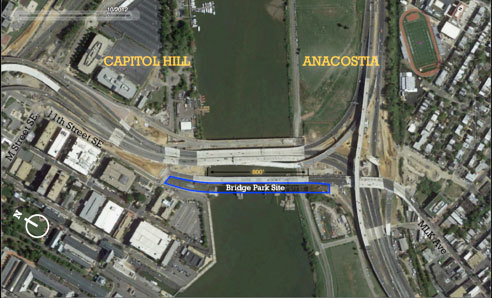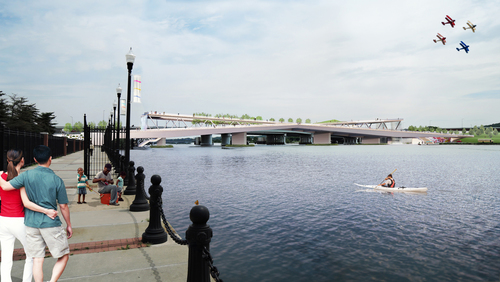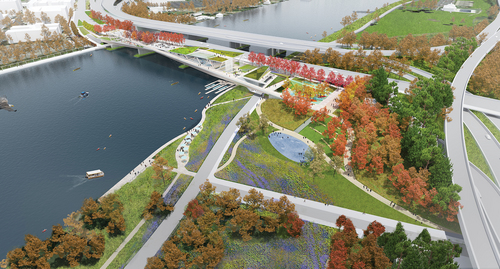Can a park bridging the Anacostia bring investment without displacing residents?
If the plan to build a park over the old 11th Street Bridge comes to fruition, there’s no question it will change Anacostia. For now, the people behind the park are working hard to ensure that the people who are there now will be able to stick around to enjoy it.
The 11th Street Bridge park is a proposal to build a spectacular public space on remaining parts of a disused bridge over the Anacostia River. Having just selected a design this spring, its director Scott Kratz and his team are developing the design, raising money, and running engineering tests. Despite reports that they don’t have money, the project is going according to plan.
While waiting to begin construction, Kratz and his team have started to address a big worry many have voiced about the project: the risk that it will spur gentrification east of the Anacostia River, specifically in the HIstoric Anacostia neighborhood.

Image from the 11th Street Bridge Park.
This Saturday, a group of real estate experts, planners, and community leaders will present a preliminary plan meant to ensure that the Bridge Park benefits all residents, not just those who can afford to buy in a hot market. Called the Equitable Development Task Force, the group will hold meetings on each side of the river. At both meetings, they’ll present a plan and then look to the experience of residents to refine their objectives and methods.
I spoke with Scott Kratz, the 11th Street Bridge Park’s director last week. He said that technical problems like designing and building the park seem simple compared to the challenge of making sure it adds social landscape without displacement and disaffection.
Could the park be a bridge to gentrification?
Back when the idea of reusing an old highway bridge as a park was just talk, over on the west side of Manhattan, real estate prices were doubling and tripling around the High Line, a park built on an abandoned railway viaduct. In just a few years, the Meatpacking District went from slaughterhouses and sex work to a high end retail district with equally high-end apartment buildings.
Many writers have compared the Bridge Park to the High Line, and while there are some key differences, they share a cultural cachet: they’re both infrastructure-reuse projects by fashionable design firms in distinctive locations with attractive, historic neighborhoods nearby.
Capitol Hill and Historic Anacostia already have many qualities that make a neighborhood desirable. With a signature project, the market could heat up. Kratz laments that already, two years too early, real estate listings for locations miles away are hyping the unbuilt park as an amenity.
With wealthier residents often come resources, government attention, and more retail. At the same time, the consequences of displacement are serious.
Residences east of the River are overwhelmingly rental, so they can turn over faster, without wealth accruing for renting residents the way it does with homeowners. Unemployment is high. A disproportionate number of residents suffer from diseases associated with poverty, sedentary lifestyles, and stress. Their lives will not get easier if they have to move farther from the city’s core, where both mobility and access to social networks is harder.
The problem, with most incidences of gentrification, Kratz says, is that markets are way faster than governments or non-profits. Attempts to freeze rents or rush in new construction always happens too late. Social organizations are left trying to fix problems that are arising faster than they can hope to address them.
Or is it a bridge to opportunity?
Unlike a lot of projects, the Bridge Park is well-positioned to be proactive about confronting these problems and ensuring that the project benefits as many people as possible. Officials know more or less when the project will come online, 2017 or 2018, and they know exactly what area it will affect.
Originally, Bridge Park staff focused exclusively on keeping the existing housing affordable. But after meeting with residents from east of the Anacostia River, they realized that that was too narrow a focus.
Now, they’ve widened the goals to doing a small part in helping nearby communties grow wealthier and more socially connected. The staff want to use the 11th Street Bridge Park to catalyze the amount of affordable housing in the area, increase employment, and promote locally own businesses that keep wealth in the community.
These are huge goals, especially for an organization that exists mostly just to build a park. To meet them, the Bridge Park team is considering possibilities on two levels: measures it can actually take, and ways it can influence things through publicity and connections.
To take action, the Bridge Park needs help from the community
Kratz realizes that neither he nor the Equitable Development Task Force can figure out how to solve a problem like displacement. So, first the Bridge Park team reached out to organizations who have been grappling with these issues in nearby communities organizations for years. Then, they looked at similar projects outside the region, to see if there were any specific lessons for signature parks in mixed-income areas.
The Task Force won’t release the full panel until tomorrows’s meeting, but Kratz provided some example approaches. Conceptually, they realized they could work at two scales: what the Bridge Park can directly control and what it can only the influence through its publicity and connections.
Kratz concedes the Bridge Park can’t control all that much when it comes to affordable housing, But he also says the hope is that his team can unite area political leadership, which could then shape development through community land trusts that assemble equity for below-market housing, renovation assistance to homeowners, and political pressure for public investment.
One example of this kind development the task force will highlight is the extensive affordable housing program spurred by the Atlanta BeltLine.
Kratz says the Bridge Park can work directly on workforce development. The park is effectively a giant green roof that can serve as a training ground for employment in sustainable infrastructure. Related interventions might be the wellness and urban agriculture goals of the park, which could reduce job-impeding health problems.
Finally, the task force has suggestions for fostering local businesses. One is to model the Bridge Park’s cafe after Union Market, a space that serves as an incubator for restaurants. The Bridge Park’s visibility could launch a small business to commercial self-sustainance without the large capital investments required to start a restaurant.
Kratz notes that these ideas are only small parts of a solution. But, he emphasized that the Bridge Park’s ambitions were most likely to succeed when they built on the work community groups were already doing on both sides of the Anacostia.
To be sure, the Bridge Park staff have met with existing organizations and asked how the project can fit into their existing strategies. The staff has also attended community meetings to hear residents’ concerns and needs and to learn about how residents live and what they value. The Equitable Development Task Force used this first round of feedback to write this round of ideas and they’re now looking for a second round of feedback.
Real estate advisors, landscape architects, and ordinary citizens have their own kind of expertise. Understanding the extent of each and building on it, I think, can be the beginning of a successful, community-led growth into a bigger, broader community. If it works, it can be an example to follow when other signature public projects risk large-scale disruption.


